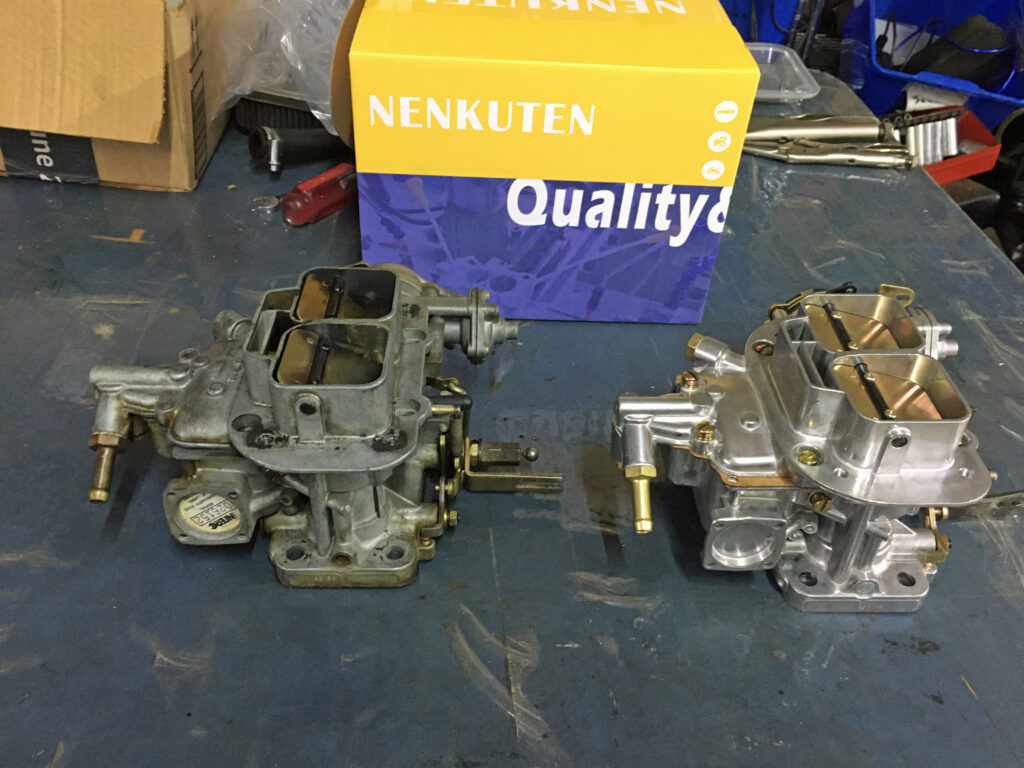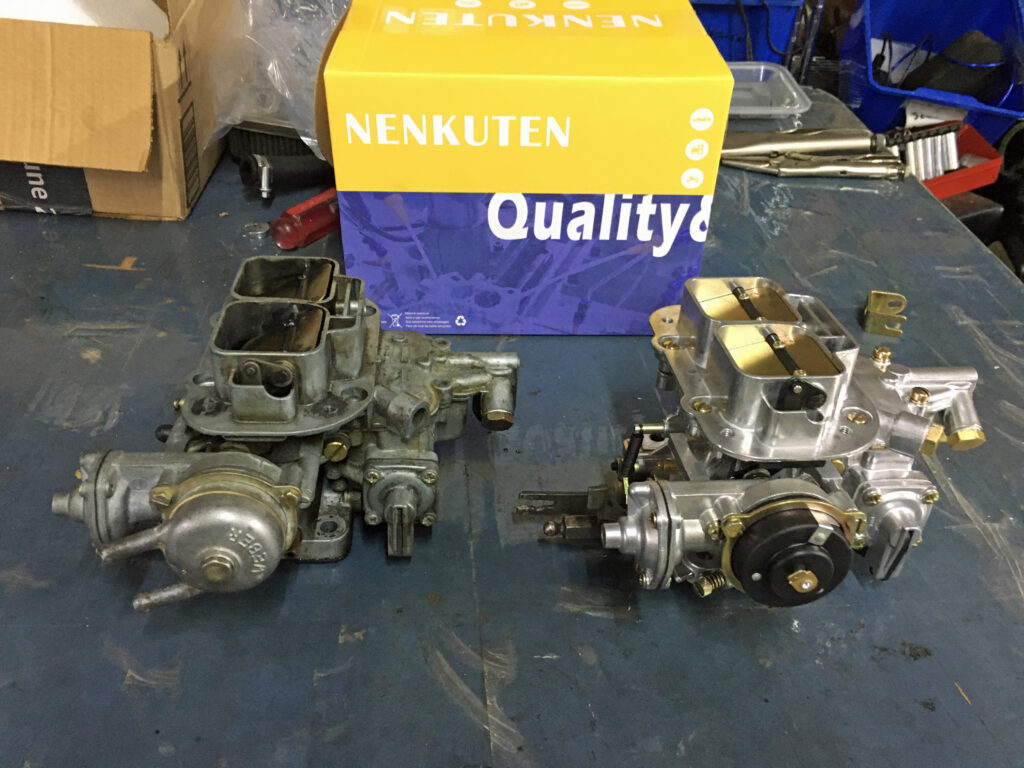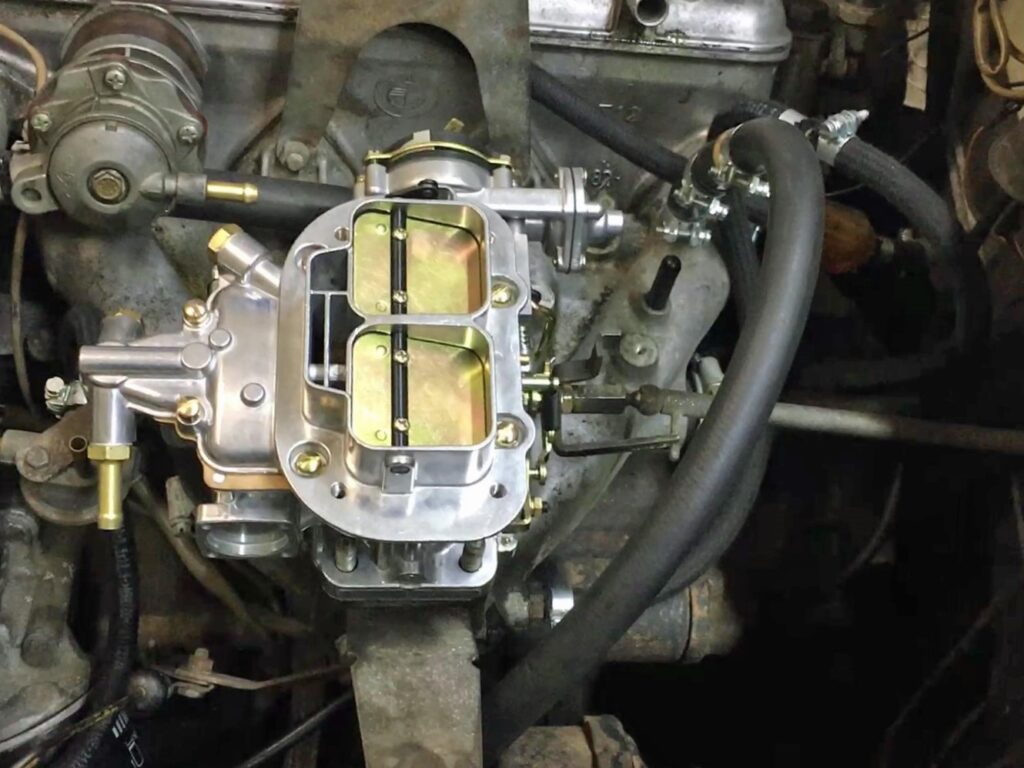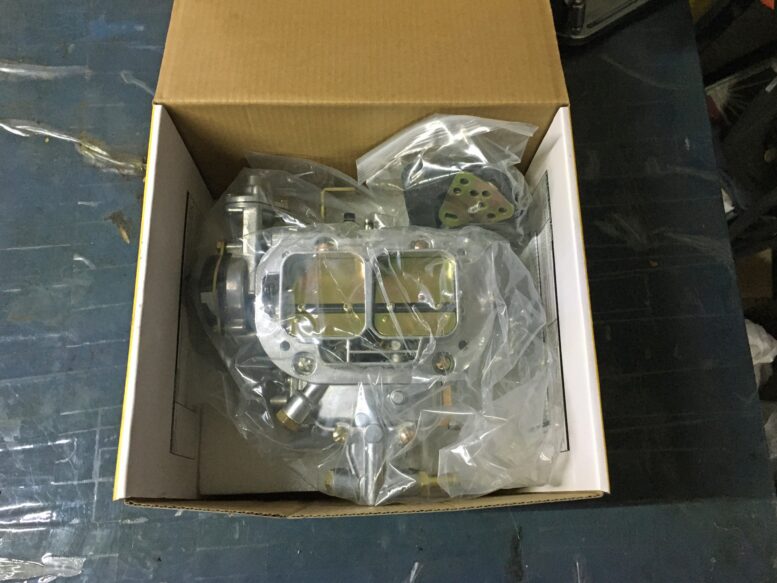Hampton, the 49,000-mile survivor ’73 2002 I bought from its original owner in 2019, has had a persistent starting problem. It seems that no matter what I do, the car is difficult to start. It’s worst in a cold garage after the car has been sitting overnight, but can also manifest itself after driving and parking for more than 20 minutes. It’s likely the problem stems from the fact that Hampton sat in a barn for ten years before I bought it and the carburetor never had a full-on rebuild. In general, I’ve been lucky with carburetors in long-sitting cars. I generally just pull the top off, make sure the float bowl isn’t a varnished gooey gummy mess, vacuum out any obvious sediment, verify that the jets aren’t clogged, and put it back together. This worked fine for my 26-year-sitting 2002 Bertha and for my Lotus Europa which sat in a storage container for three decades, but Hampton has been stubborn. In the traditional triaging of “is it fuel or is it spark,” it’s clearly fuel because the car has good spark and, when it won’t start, typically fires up with a blast of starting fluid. It’s especially frustrating because once the car is warmed up, the Weber 32/36 carb seems to work perfectly fine. Over the years I’ve replaced the idle cut-off solenoid (the anti-dieseling device) with non-solenoid version, removed the EGR valve and its plumbing to be certain the cause isn’t a vacuum leak, and re-jetted the Weber, but whenever I think I’ve solved it, I find a few days later that the problem is still there.

You have been a troublesome little Weber.
Note that this is a distinctly different problem than that of a dry float bowl from sitting, which is something that affects all my carbureted cars if they’ve been in the rented warehouse spaces for several months. Also note that while I’m not a carburetor whiz (I’m generally better with tiis), I’m certainly more than competent in dealing with the usual issues of adjusting idle mixture, idle speed, choke rotation, and the screw on the choke’s fast idle cam, as well as making sure that the accelerator pump is squirting down the throat, adjusting the float level, inspecting and blowing out jets, and increasing jet size to solve obvious lean-running issues. So whatever the issue with the Weber is, I don’t think it’s one of these. Plus at one point, I did remove every jet and blow out every passageway with compressed air, and that didn’t make any difference either. I began to think that maybe, to solve the problem, I needed a bigger hammer, but spending the $500 needed to replace it with a genuine Spanish-made Redline-boxed Weber 32/36 DGEV was more hammer than I was prepared to buy.
So I did something that someone in my position—that is, someone who writes repair-related articles and occasionally justifies questionable repair approaches as Hack Mechanic journalism—can do: I looked into buying one of those inexpensive Chinese-made Weber 32/36 knock-offs. These are all over eBay and Amazon for about 1/4 to 1/5 the cost of a genuine Weber, and there are videos on YouTube of people unboxing, evaluating, and installing them, but I was surprised that I couldn’t find a review on BMW2002FAQ.com of anyone trying one out on a 2002.
So I did it. I bought one. As an experiment to see how well it would work. To take one for the team. For you, my faithful readers.
Your Hack Mechanic. Living on the edge so you don’t have to.

Yup. Clicked and bought.
Note that I did not do this capriciously. I applied a fair amount of care to the process, and had a few requirements. It had to be a 32/36 DGV progressive two-barrel like the one currently on Hampton, not a 38/38 synchronous two-barrel. It had to look like a Weber 32/36 (the photos for some of the knock-offs on eBay show them as having an odd almost teardrop-shaped top). I paid a higher price to buy one on Amazon instead of eBay so I could return it if it didn’t fit, didn’t work, or was absolute crap, and so I could have the benefit of feedback and reviews. And the reviews had to include confirmation that the Chinese copy accepted standard Weber jets (reportedly, not all of them do).
With that due diligence done, for $115 I ordered this “Nenkuten” 32/36 DGEV (electric choke) here on Amazon. Curiously, neither this nor any other inexpensive 32/36 sold on Amazon lists BMW in the title or the BMW 2002 in the details as one of the applications. They all say something like “for Toyota Pickup 20R 22R Engine Datsun Pickup 510 610 620, For Holley Mazda B2000 B2200 Nissan Sentra 720 Pulasar [sic] CJ5 CJ7 CJ8.” Equally curiously, the cheap 38/38 clones do list BMW in the title and do specifically list “Compatible with BMW 2002 1968-1976 E10, for BMW 2002tii 1971-1974 E10, for BMW 320i 1977-1983 E21” in the detailed description. So I wasn’t in fact guaranteed that the Nenkuten would side onto the studs on Hampton’s intake manifold, but I couldn’t imagine that anything labeled “Weber DGV” had different hole spacing.
The Nenkuten had an overall 4.5 rating and based on 44 inputs. That’s not thousands, but it’s better than something that only a handful of people have provided feedback on. In addition, there was a little text box that said that over 50 of them had been sold in the last week, and there wasn’t the Amazon warning box saying that the item had a high return rate. The main negative comments from a few buyers who reported that the spring in the electric choke had been installed backwards, causing the choke to close instead of open as it warmed up. And yes, the reviews specifically confirmed that standard Weber jets could be used.
Before I installed the Nenkuten Weber clone, I reset the timing on Hampton’s recently-installed vacuum advance distributor, dialing in about 40° of total advance with the vacuum diaphragm disconnected. I drove the car and verified that it ran fine, left it in the cold garage overnight, and in the morning, with it dead-cold, verified that it still had the hard-starting problem. I then left the timing alone to be certain that wasn’t interfering with the carburetor comparison.
The $115 Weber 32/36 DGEV arrived. I unboxed and inspected it. When it passed my superficial evaluation, I removed the genuine Weber 32/36 DGAV (water choke) off Hampton so I could compare the two carbs side-by-side on the table.
Other than the clone feeling lighter than the original, and the different chokes, the only obvious external difference was in the linkage: The bracket on the clone’s linkage was shaped like a “C” whereas the on the real thing was “L”-shaped. Also, the clone was missing the tall hex nut with the ball on the top that the 2002’s linkage arm needs to snap onto.

To work on the 2002, that “C”-shaped needs to be “L”-shaped, and a hex standoff with a linkage ball at the top needs to be screwed on.
I thought I’d need to pull these two parts off the original Weber, but then remembered that I had an old parts 32/36, so I pulled the bracket and the nut-with-linkage-ball off it and swapped them onto the clone. Below are the side-by-side pics of the two carbs.

The side-by-side comparison. Note that I’ve removed the “C”-shaped linkage bracket the clone came with (shown on the table) and installed an “L” bracket and a standoff with a linkage ball.

As David Bowie said, “Fashion… turn to the left…”

Is this my good side?

You can see the water choke on the DGAV (left) that was on the car, versus the electric choke on the DGEV clone (right).
Just to be certain the Weber clone was indeed a progressive two-barrel carburetor (the throttle on the second barrel staying closed until the primary barrel is 2/3 open), I flipped it over and worked the bracket on the main throttle shaft. Initially it didn’t behave progressively—both barrels opened together. However, that turned out to be my error—when I’d removed the “C” bracket and installed the “L” bracket, I’d accidentally put a washer in the wrong place. With that corrected, the barrels opened properly.

The clone Weber’s primary barrel 2/3 of the way open, causing the secondary to begin to move.
With the correct linkage pieces installed, I test-fit the Nenkuten clone Weber on the car. It slid right into place on the manifold’s studs, and the linkage bar mated up with the bracket and ball.

Nice.
And, with that, I buttoned things up.
So… did the $115 Nenkuten clone Weber solve Hampton’s longstanding starting problem? Were there other configuration issues? Did the car run as well as it did with the genuine Weber? Did Dudley Do-Right save Nell? You’re going to have to tune in next week. Hey—I have a part I need to pay off. Remember, I’m only doing this for you.
—Rob Siegel
____________________________________
Rob’s newest book, The Best of The Hack Mechanic, is available here on Amazon, as are his seven other books. Signed copies can be ordered directly from Rob here.
Tags: 2002 carburetor replacement non-oem repair




















